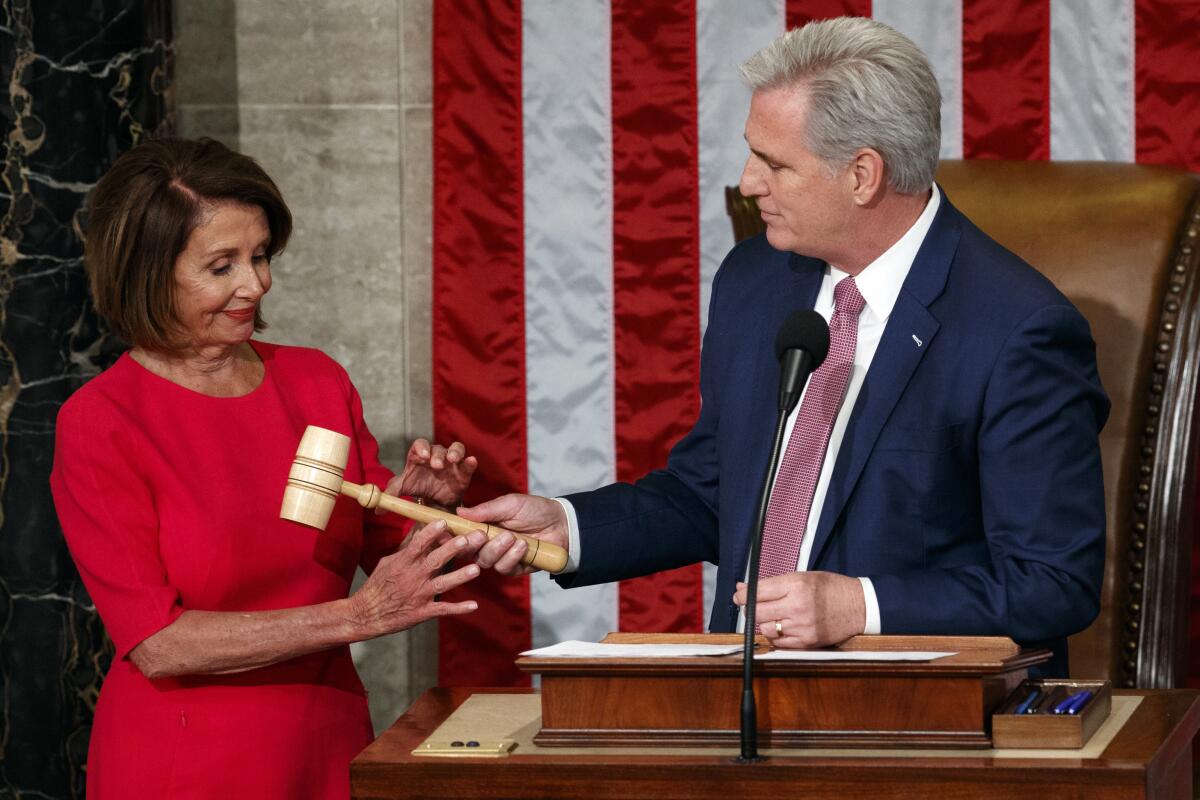With Kevin McCarthy out, Nancy Pelosi once again outlasts her foes

WASHINGTON — Since Kevin McCarthy‘s ouster as House Speaker, I have wondered whether the Bakersfield Republican would try to hang on to his seat as a backbencher or cash in on K Street, like so many of his predecessors.
Part of the answer was revealed last week : He’s headed for the exit, though he has yet to say what he will do next.
As McCarthy leaves the stage, it’s worth noting that his nemesis, San Francisco Rep. Nancy Pelosi, has outlasted yet another of her foes.
Like other Republican House speakers, McCarthy is quitting Congress after struggling to wrangle the far-right members of his conference. Some of those members complained about his repeated reliance on bipartisanship to pass legislation when they harnessed Democratic votes to kick him out of the speaker’s chair on Oct. 7.
The same faction that made the job challenging for McCarthy effectively ran off two previous House speakers — Reps. John A. Boehner and Paul D. Ryan.
In contrast to the unending mayhem on the GOP side of the aisle, Pelosi was not pushed out of Congress by her party after stepping down as its leader. In fact, Pelosi seems to be very much enjoying her life as speaker emerita.
How has the first woman speaker managed to outlast her Republican rivals? Like them, Pelosi has also battled with rambunctious members of her own caucus. But she has kept her side of the street clean, if you know what I mean.
Hello, my name is Erin B. Logan. I cover Congress for the L.A. Times. Today, we are going to discuss why so many House speakers fade, but Pelosi is still here.
Get our L.A. Times Politics newsletter
The latest news, analysis and insights from our politics team.
You may occasionally receive promotional content from the Los Angeles Times.
It’s coming back around
When the House Republicans recaptured the majority in 2011, Pelosi lost the speaker’s gavel to Boehner of Ohio. The GOP made gains during then-President Obama‘s first midterm election thanks to the tea party, a far-right movement that championed limited government that worked to elect archconservatives to Congress.
The tea party attracted lots of support from white Americans who displayed higher levels of racial resentment and felt threatened by the election of the first Black president, the Stanford social scientist Robb Willer and two colleagues argued in a 2016 paper. It also pushed the entire GOP to the right, challenging and threatening incumbents, especially those willing to compromise with Democrats, in primary elections.
Tea party lawmakers who won their seats by arguing that bipartisan deals were the source of Washington’s problems didn’t display much interest in compromising with Obama to keep the government running, and their intransigence forced Boehner to turn to Democrats to help pass key legislation. Boehner’s repeated reliance on bipartisanship gave way to rumors of a mutiny, forcing the Ohioan to resign from Congress in 2015.
The far-right House Freedom Caucus, which was founded that year, adopted the tea party’s modus operandi, and the movement’s energy overtook the GOP the following year with the election of Donald Trump to the White House.
Boehner’s successor, Ryan of Wisconsin, ran into the same problems Boehner had. Though Ryan was easily elected to the speaker’s chair, working under the Trump administration made his job harder, and while he initially said his departure in 2019 had nothing to do with his irritation with Trump, Ryan has spent much of his post-congressional life blasting the former president.
‘I don’t think about him at all’
Pelosi’s problems were different. Over her decades in Congress, leftist progressivism has become more prominent in the Democratic Party, with new and younger lawmakers pushing party leadership in uncomfortable ways. Pelosi was able to repeatedly navigate these divisions, commanding an unmatched level of power and influence.
But although Pelosi has outlasted her GOP rivals, “she has barely survived,” said Jeffery Jenkins, a political scientist at USC .
Jenkins noted that, like McCarthy, Pelosi has faced her own party struggles to maintain her leadership. Over the years, Pelosi had to repeatedly court rebellious Democrats to maintain her hold on leadership. Though the battles were never as embarrassing as McCarthy’s January speakership bid — which took 15 ballots and four days — they were significant. Still, she managed to survive not just because of her “superior leadership skills,” but also because her conference is much easier to wrangle than the GOP, Jenkins said.
The far-left wing of her party “have all been reasonable to work with, as they see the ‘game of politics’ the same,” he said. Progressives, like more moderate Democrats, came to Washington to get work done, and are willing to work with the opposing side to pass legislation when it serves their interests.
The GOP far-right wing is “firmly antiestablishment” and uninterested in cutting deals with Democrats, Jenkins said. This faction wants to “completely upend the system and drastically shrink the federal government.” In September, hard-line Republicans voted against McCarthy’s bipartisan plan to avert a government shutdown because it did not include key spending cuts.
Within three days of that floor vote, eight far-right GOP rebels leveraged the Democratic conference to remove McCarthy from the speaker’s chair, throwing the chamber into chaos and effectively ending the Californian’s political career.
Pelosi meanwhile never faced a mutiny like McCarthy’s and has been able “to stick around, while leaders on the Republican side have retired and been pushed aside,” Jenkins said.
Though they are foes, McCarthy doesn’t live rent free in Pelosi’s mind, she told the Times last week.
“I didn’t think about him at all. Period. Zero,” she said. “Once you’re gone from here, you’re gone from here.”
The latest from the campaign trail
—With McCarthy heading for the exit, his Republican colleagues are bracing for a falloff in campaign support and loss of granular institutional knowledge that could leave them at a disadvantage heading into next fall’s elections, Times writer Cameron Joseph reported.
—Special counsel Jack Smith on Monday asked the Supreme Court to take up and rule quickly on whether former President Trump can be prosecuted on charges he plotted to overturn the 2020 election results, the Associated Press reported.
Enjoying this newsletter? Consider subscribing to the Los Angeles Times
Your support helps us deliver the news that matters most. Become a subscriber.
The view from Washington
—A divided Supreme Court on Monday turned down a Christian group’s free-speech challenge to the laws in California and 21 other states that forbid licensed counselors from using “conversion therapy” with children and teenagers, Times writer David G. Savage reported.
—As Israel widens its war in Gaza, now in its third deadly month, Biden administration officials are struggling to shore up support for the government of Benjamin Netanyahu even as it appears to ignore U.S. advice and Arab anger worldwide mounts, Times writer Tracy Wilkinson reported.
—Ukraine came under heavy attack from the air and from cyberspace Tuesday, local officials said, as nearly 600 Russian shells, rockets and other projectiles rained down on a southern region and unidentified hackers knocked out phone and internet services of the country’s biggest telecom provider, the Associated Press reported.
The view from California
—As President Biden arrived in Los Angeles on Friday for a weekend of fundraising among Hollywood elites, his only living son was hit with his second grand jury indictment this year — with the special counsel accusing Hunter Biden of various tax crimes, Times writer Matt Hamilton reported.
—Biden’s arrival in Los Angeles was greeted not just by well-heeled supporters, but also hundreds of protesters who gathered outside a glitzy Westside fundraiser to demand a cease-fire in the Gaza Strip, Times writers Laura J. Nelson and Courtney Subramanian reported.
—As part of an ongoing Metro effort to build housing and community around transportation hubs, a new mixed-use development dubbed District NoHo is coming to North Hollywood’s Metro station, Times writer Caroline Petrow-Cohen reported.
Times writer Cameron Joseph contributed reporting. Sign up for our California Politics newsletter to get the best of The Times’ state politics reporting. And don’t forget to follow me on Twitter and send pictures of your adorable furbabies to me at erin.logan@latimes.com.
Stay in touch
Keep up with breaking news on our Politics page. And are you following us on Twitter at @latimespolitics?
Did someone forward you this? Sign up here to get Essential Politics in your inbox.
Until next time, send your comments, suggestions and news tips to politics@latimes.com.
Get the L.A. Times Politics newsletter
Deeply reported insights into legislation, politics and policy from Sacramento, Washington and beyond. In your inbox three times per week.
You may occasionally receive promotional content from the Los Angeles Times.




